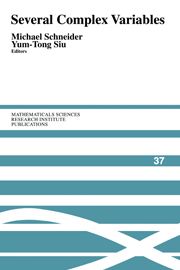Book contents
- Frontmatter
- Contents
- Preface
- Local Holomorphic Equivalence of Real Analytic Submanifolds in ℂN
- How to Use the Cycle Space in Complex Geometry
- Resolution of Singularities
- Global Regularity of the ∂-Neumann Problem: A Survey of the L2-Sobolev Theory
- Recent Developments in the Classification Theory of Compact Kahler Manifolds
- Remarks on Global Irregularity in the ∂-Neumann Problem
- Subelliptic Estimates and Finite Type
- Pseudoconvex-Concave Duality and Regularization of Currents
- Complex Dynamics in Higher Dimension
- Attractors in ℙ2
- Analytic Hilbert Quotients
- Varieties of Minimal Rational Tangents on Uniruled Projective Manifolds
- Recent Developments in Seiberg-Witten Theory and Complex Geometry
- Recent Techniques in Hyperbolicity Problems
- Rigidity Theorems in Kahler Geometry and Fundamental Groups of Varieties
- Nevanlinna Theory and Diophantine Approximation
Recent Developments in the Classification Theory of Compact Kahler Manifolds
Published online by Cambridge University Press: 25 June 2025
- Frontmatter
- Contents
- Preface
- Local Holomorphic Equivalence of Real Analytic Submanifolds in ℂN
- How to Use the Cycle Space in Complex Geometry
- Resolution of Singularities
- Global Regularity of the ∂-Neumann Problem: A Survey of the L2-Sobolev Theory
- Recent Developments in the Classification Theory of Compact Kahler Manifolds
- Remarks on Global Irregularity in the ∂-Neumann Problem
- Subelliptic Estimates and Finite Type
- Pseudoconvex-Concave Duality and Regularization of Currents
- Complex Dynamics in Higher Dimension
- Attractors in ℙ2
- Analytic Hilbert Quotients
- Varieties of Minimal Rational Tangents on Uniruled Projective Manifolds
- Recent Developments in Seiberg-Witten Theory and Complex Geometry
- Recent Techniques in Hyperbolicity Problems
- Rigidity Theorems in Kahler Geometry and Fundamental Groups of Varieties
- Nevanlinna Theory and Diophantine Approximation
Summary
We review some of the major recent developments in global complex geometry, specifically:
1. Mori theory, rational curves and the structure of Fano manifolds.
2. Non-splitting families of rational curves and the structure of compact Kahler threefolds.
3. Topology of compact Kahler manifolds: topological versus analytic isomorphism.
4. Topology of compact Kahler manifolds: the fundamental group. 5. Biregular classification: curvature and manifolds with nef tangent/anticanonical bundles.
Introduction
This article reports some of the recent developments in the classification theory of compact complex Kahler manifolds with special emphasis on manifolds of non-positive Kodaira dimension (vaguely: semipositively curved manifolds). In the introduction we want to give some general comments on classification theory concerning main principles, objectives and methods. Of course one could ask more generally for a classification theory of arbitrary compact manifolds but this seems hopeless as most of the techniques available break down in the “general” case (such as Hodge theory). Also there are a lot of pathologies which tell us to introduce some reasonable assumptions. From an algebraic point of view one will restrict to projective manifolds but from a more complex-analytic viewpoint, the Kahler condition is the most natural. Clearly manifolds which are only bimeromorphic to a projective or Kahler manifold are interesting, too, but these will be mainly ignored in this article and might occur only as intermediate products. The most basic questions in classification theory are the following.
(A) Which topological or differentiate manifolds carry a complex (algebraic or Kahler) structure? If a topological manifold carries a complex structure, try to describe them (moduli spaces, deformations, invariants).
Information
- Type
- Chapter
- Information
- Several Complex Variables , pp. 113 - 160Publisher: Cambridge University PressPrint publication year: 2000
Accessibility standard: Unknown
Why this information is here
This section outlines the accessibility features of this content - including support for screen readers, full keyboard navigation and high-contrast display options. This may not be relevant for you.Accessibility Information
- 1
- Cited by
